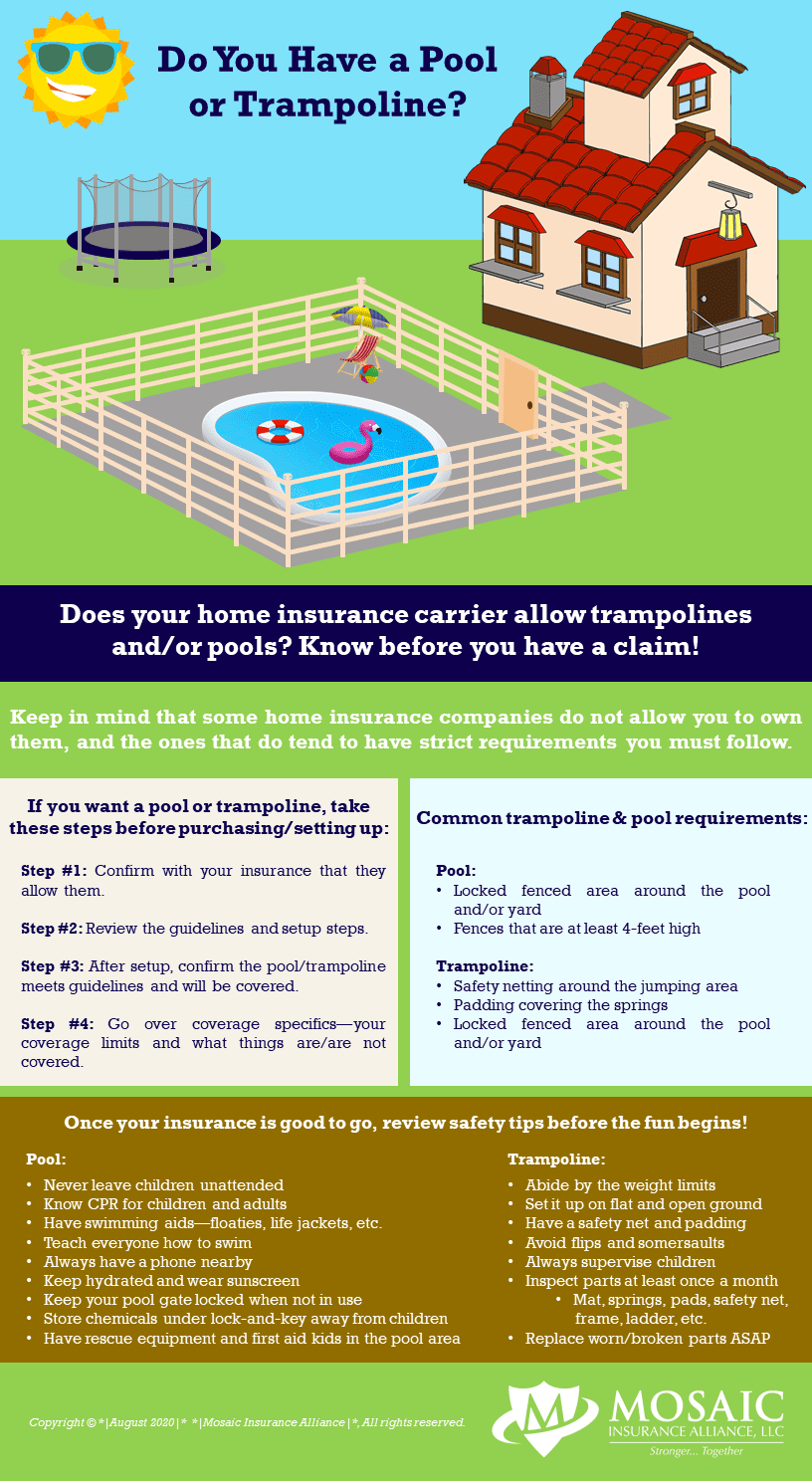You Should Review Your Home Insurance Before Buying Summertime Toy
With the COVID-19 quarantine, there has been a bigger spike than normal in summer toy sales—everything from Slip’n’Slides to trampolines and pools. Kids are needing outlets to burn off all that extra energy while they practice safe distancing from the public, and the nice weather in Everett, Edmonds, Seattle, Bellevue, and surrounding cities have made these outside home activities skyrocket to the top of parents’ lists in the Pacific Northwest.
But what does that mean for your home insurance? It is not all fun and games, unfortunately. Before making the purchase, we recommend that you review your home insurance policies with your agent or insurance carrier. Afterall, pools and trampolines are not only dangerous, but are also attractive nuisances—items that attract children and teenagers. Attractive nuisances increase the likelihood of unexpected injuries (i.e. your kids invite friends over to swim without asking you and one of them drowns, passerby kids decide to trespass on your property to jump on the trampoline and one of them breaks a bone, etc.).
But do you have to insure your pool or trampoline by law?
Technically there is no law in the state of Washington that requires you to have your pool or trampoline insured. But your home insurance company has its own regulations in place that you must follow to be covered and remain covered, and it is in your best interest to get insurance that allows you to own a trampoline or pool. You should always tell your insurance company if you make a purchase that might impact your insurance, like purchasing a trampoline or pool, if you want to make sure that a future claim will be covered and that you can remain their client. (It is highly recommended that you speak to your insurance carrier before making any such purchase.) Also, if you rent your home, in addition to talking to your renters insurance company, you should always talk to your landlord to make sure they have no objections and that their homeowners insurance will allow it.
You must abide by the rules and regulations within your insurance policy, like with any contract. If your insurance requires that your pool follows certain criteria, you will need to meet their requirements to have valid coverage. If your insurance says that you cannot have a pool or a trampoline at all, you will have to get rid of it to remain a client. Additionally, having your pool and/or trampoline insured means that if a covered loss were to occur, your insurance company will help pay for damages. The last thing you want is to have to pay out-of-pocket for costly hospital bills and/or other related costs—like legal fees if you are sued.
If you want to have a pool or trampoline, follow these steps:
- Confirm with your insurance carrier that you can have a pool or trampoline on your insurance policy before purchasing or setting it up. If you cannot have a trampoline and/or pool with the current provider that you have, a Mosaic agent can help you find a carrier that will cover you. We have access to numerous top carriers. Contact us for a free quote at (425)-320-4280, info@mosaicia.com, or online.
- If your insurance carrier allows pools/trampolines, ask your agent to review the guidelines you need to abide by to have it covered on your insurance, and any steps you will need to take to get it setup and insured. If your carrier allows a trampoline/pool, and you do not abide by carrier requirements and a claim were to occur, your coverage may be nullified. For example, many insurance policies require that there be a fence around the pool or the yard where it is contained, and they have specific fence requirements (i.e. it has to have a lock and be at least 4 feet tall).
- Reach back out to your agent before using the pool/trampoline to confirm that you did all the steps, and that the item meets guidelines. Some insurance carriers require a home-visit inspection to ensure coverage.
- In addition, you will want to understand coverage specifics, including what will be covered in the event of a claim and your coverage limits. You will want to understand when a company will pay if a claim involves your trampoline, and you will want to make sure that you have enough protection in case someone gets seriously hurt, whether it be your own child, a guest, or a trespasser. Some insurance policies will not pay for injuries from a trampoline, and other policies will pay for injuries but not damages done to the trampoline (i.e. if it is stolen, vandalized, broken in a storm, etc.). Limits can add up fast when it comes to hospital bills and other claim expenses. Your Mosaic agent can help determine what limits will give you ample coverage for your situation. The Mosaic team can also help you get an umbrella policy, which are great policies to have if you own a pool or trampoline because thy will expand your coverage options and limits.
Common Things That Insurance Carriers Require Your Trampoline to Have:
- Safety netting around the jumping area
- Padding covering the springs
- Located in an enclosed space (like a locked backyard fence)
Common Safety Protocols Insurance Carriers Require for Your Pool:
Typically pools that need to be on your home or property insurance policy are larger ones that are above ground or in-ground. They are not typically the 5-gallon kiddy pools you see at places like Walmart for toddlers, but every policy is different, and each insurance company has its own requirements. It is best to check in with your insurance company and let them know what pool you have or are looking into getting.
Common pool requirements include:
- Locked fenced area around the pool and/or yard
- Having a fence(s) that is at least 4-feet high
After your pool/trampoline is deemed good to go on your insurance, read up on some safety tips before the fun begins:
Pools:
- Avoid anyone swimming alone, including adults.
- Keep items in the pool that help people swim (i.e. floaties)
- Have younger children wear safety gear like life jackets and arm floaties
- Have more adults than children so that every child can always be looked after
- Every child should always have at least one adult watching them
- Young children (like toddlers) should always be accompanied/held by an adult inside the pool
- Tips from the US Consumer Product Safety Commission:
- Never leave children unattended
- Always have a phone nearby
- Teach safety tips to those who are going to swim and/or supervise
- Teach kids how to swim
- Know CPR for both children and adults
- Centers for Disease Control and Prevention Tips:
- Keep hydrated, especially on hot days
- Avoid distractions—you will want to always be alert and watching the swimmers (i.e. do not play on your phone)
- Wear waterproof sunscreen
- More pool owner tipshere.
- Here are some additional pool safety tips from Nationwide:
- Always keep your pool gate locked when not in use
- Have a locked fence around your yard
- If a child goes missing on or near your property, check the pool first
- Do not keep objects near the fence that can be used for climbing over it
- Store chemicals in hard-to-reach areas that are locked and away from children
- Install security cameras
- Have rescue equipment and first aid kits in the pool area
Trampolines:
- Know the weight limit of your specific trampoline and do not exceed the limit
- Setup your trampoline on flat ground
- After setting it up, have an adult cautiously test it out before children
- Always supervise children
- Avoid flips and somersaults
- Have a sturdy safety net around the trampoline and a safety pad covering the springs
- Do not use a trampoline if it has rusty springs or mat tears—replace those items immediately
- Domi Jump tips:
- Read their blog post for the 7 most important parts you should replace and how often to check these trampoline parts.
- Domi also has 21 trampoline tips, which include tips like:
- Setup the trampoline in a clear area (no nearby things jumpers could hit like trees and fences)
- Make sure that all parts are in place properly and operating adequately
- Monitor children to avoid rough play or jumping too high
- Do not wear jewelry while jumping
- Have a trampoline ladder for getting on and off, but remove it before anyone starts jumping
- Always make sure that the trampoline does not have anything underneath it before getting on it
- Children under age 6 should not be on a full-size trampoline
- Nationwide trampoline safety tips:
- Do not jump off the trampoline
- Do not jump on the trampoline if it is wet
- Have it in a fenced and locked area
- Do not put the trampoline on concrete or other hard surfaces without having a trampoline safety net and/or cash mat.
- Have a round trampoline instead of a square one (square ones have a dangerously high bounce)
Have a fun and safe rest of your summer, everyone! For a nice insurance and safety tip guide on trampolines and swimming pools, save our PDF infographic below! If you have any questions or concerns, we are here. Reach out to your Mosaic agent directly, or call/email our mail line at (425)-320-4280info@mosaicia.com . If you own a business, we can also help you get insurance. Send our commercial insurance team an email at commercial@msoaicia.com .
Sources: Progressive Insurance, Nationwide Insurance, The US Consumer Product Safety Commission, Centers for Disease Control and Prevention, and DomiJump.com.


